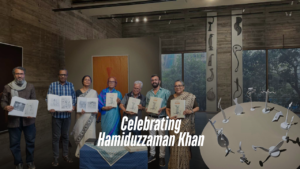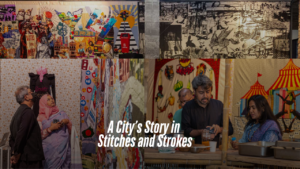Day: April 10, 2025

Celebrating Hamiduzzaman Khan
From 31 January to 15 March, the first-floor gallery of the capital’s Bengal Shilpalay transformed into a mesmerizing display of incredible sculptures and paintings. Titled “Hamiduzzaman Khan,” the spectacular exhibition organized by Bengal Arts Programme honored the life and works of Hamiduzzaman Khan, one of Bangladesh’s most distinguished sculptors. The inauguration took place on Jan 31, graced by the presence of artist and art writer Mustafa Zaman; the director general of Bengal Foundation, Luva Nahid Choudhury; prominent Bangladeshi-Spanish artist Monirul Islam; and architect Mustapha Khalid Palash. Neatly curated by the esteemed Mustafa Zaman, the exhibition was a visual diary of Hamiduzzaman’s lifelong dedication to modern experimental art, which provided visitors with a profound insight into his artistic journey. Some pieces were delicate and intricate, while others were monumental and commanding. His use of geometric abstraction and semi-abstract forms is a testament to his imagination and craftsmanship. The artist has spent decades exploring new artistic dimensions. His ability to transform objects into unique sculptural forms has captivated art lovers even beyond borders for decades. The exhibition at Bengal Shilpalay featured quite a big collection of his artworks, showcasing his talent across multiple mediums including metal and stone sculptures, watercolor paintings, and acrylic paintings inspired by his sculptures. It also showcased some of his sketches, exhibition catalogues, and books on his art. The curator, Mustafa Zaman, praised the artist’s innovative approach to form and structure. He remarked, “Hamiduzzaman sir has consistently delved into the essence of objects, transforming and redefining their shapes in extraordinary ways. His creations showcase decades of dedication and artistic exploration, reflecting a deep commitment to pushing boundaries and reimagining possibilities.” Zaman highlighted the artist’s ability to blend tradition with experimentation, resulting in works that are both timeless and groundbreaking. Hamiduzzaman’s art, he noted, stands as a testament to his relentless pursuit of reinterpreting the familiar into something profoundly unique and thought-provoking. Prominent architect Mustapha Khalid Palash, a guest at the inauguration, shared his admiration, saying, “His simple yet deeply impactful works remain a source of inspiration. This exhibition beautifully celebrates his artistic legacy, offering younger generations a chance to reflect on and reconnect with their cultural roots. It’s a tribute to his enduring influence and a reminder of the power of art to bridge the past and present.” Born in Kishoreganj in 1946, Hamiduzzaman Khan studied at Dhaka Art College (now the Faculty of Fine Arts, Dhaka University) and was mentored by legendary artists like Zainul Abedin, Abdur Razzaque, and Mustafa Monwar. He transitioned from painting to sculpture, pioneering sculpture parks in Bangladesh and leaving behind an impressive legacy. Some of his most popular sculptures include “Shangshaptak” at Jahangirnagar University, “Flying Bird” at the World Bank Dhaka office, “Jagrotobangla” in Brahmanbaria, “Freedom” at Krishibid Institute, and “Peace Bird” at TSC. Expressing his gratitude, Hamiduzzaman Khan spoke about his journey as an artist. “Creating modern experimental artworks in various mediums has been my passion for many years. It hasn’t always been easy, but I am grateful for the support of my peers and art lovers.” The great artistic mind further added, “I am almost 80 years old, but I want to continue making art as long as my mind and body permit!’
Read More
A City’s Story in Stitches and Strokes
Dhaka’s rapid urbanization is impossible to ignore. This city of relentless energy and transformation is a place where tradition and modernity collide amidst its bustling streets and ever-changing skyline. As the economic heart of Bangladesh, it draws thousands seeking better opportunities. But this comes at a cost: overcrowding, strained resources, and a growing disconnect between the old and the new. Against this backdrop, ShohorNama Dhaka Episode II sought to explore the city’s complexities through art. Launched in early 2024, the project brought together visual artists, architects, artisans, and students from the University of Dhaka’s Faculty of Fine Art to create a tapestry of urban narratives. And the exhibition of this project took place from February 15 to 25 at the level 4 under construction space of the capital’s Bengal Shilpalay. The exhibition was inaugurated by H.E. Marie Masdupuy, Ambassador of France to Bangladesh, on February 15, 2025. Titled after the project name, the multidisciplinary exhibition wove together the threads of urban life, resilience, and creativity. Presented by the Bengal Arts Programme in collaboration with the Britto Arts Trust, ShohorNama II was a visual love letter to Dhaka, its people, and their stories. From large appliqué tents to wood-cut prints, installations, and performance art, it was a celebration of Dhaka’s artistic topography. At its core, ShohorNama was about storytelling. One of the standout features is the Pakghor Project, a community kitchen born out of necessity during the devastating floods of 2024 in the Khulna region. Pakghor provided warm meals to 500 villagers for a week. But it became more than just a kitchen—it became a space for shared stories, resilience, and hope. The Dorjikhana Project takes a different approach, focusing on textiles and their cultural significance. Through appliqué and embroidery, artists explore the connection between traditional practices and the modern garment industry. The project also draws inspiration from Bangladesh’s fading circus traditions. Resulting in a stunning collection of textile art that speaks to both the past and the present. Another striking element of ShohorNama is its use of tents. Historically, tents have symbolized temporary shelter for nomadic communities, and in this exhibition, they represent the fluidity of migration—whether due to natural disasters, economic hardship, or political unrest. The Big Tent installation captured this impermanence, reflecting the challenges faced by marginalized communities. The exhibition also highlighted the collaborative spirit of the project. Workshops with the University of Dhaka’s Department of Printmaking and Department of Craft allowed students to contribute to large-scale works, such as woodcut prints and appliqué pieces. These workshops not only honed technical skills but also fostered a sense of shared purpose, blending individual creativity into a cohesive vision. The exhibition was a feast for the senses! As Dhaka continues to evolve, exhibitions like “ShohorNama Dhaka Episode II” remind us of the importance of preserving our stories and traditions. Through art, we can find common ground, build resilience, and imagine a better future.
Read More
Where Artist and Audience Intertwined
Amidst the quietness of Lalmatia’s Block F lies Shunno Art Space—like multidisciplinary artists, it’s also multidisciplinary in character. Limited in floor area but with an illimitable heart, the space adorns exhibitions, has a printing workshop set up, and has a café—intertwined. From February 15 to 22, this cozy space hosted artist Sanjid Mahmud’s solo exhibition “Tracing The Distance.” The week-long exhibition witnessed a vibrant crowd, and the inauguration was graced by eminent artistic figures Hamiduzzaman Khan and Mustafa Zaman. “Exhibition visitors observe art passively, only admiring the finished works. They only view; they don’t paint. But here, they were active participants. They picked up brushes and poured their emotions into the canvasses. Even those who don’t know how to draw found themselves painting. Their raw, unfiltered expressions became the foundation. Then, I stepped in, adding my artistic intervention, blending their spontaneity with my vision.” These words from the artist Sanjid himself perfectly procure the zeitgeist of “Tracing the Distance.” Sanjid Mahmud’s “Tracing the Distance” was an artistic co-production between the artist and the exhibition visitors that prioritized real-time cooperation and process over finality. Art, being a collaborative enterprise, carries remnants of prior forms by combining individual expression with common experiences. However, Sanjid Mahmud’s initiative changed the attention away from linguistic borrowing and toward overlapping artistic expressions in the moment, resulting in a dynamic interplay between creator and participant. Visitors at Shunno Art Space were greeted with empty canvases and encouraged to add spontaneously. The act of production was valued over passive viewing, encouraging people to leave their mark on the canvasses however they liked, be it sketchy motions or painterly strokes, regardless of their creative ability. This fun and engaging method relieved the pressure of normative practices, allowing for raw, unfiltered expression. Sanjid Mahmud then stepped in, responding to these inputs without striving for a certain style result. The end result was a body of work that defied decisive conclusion, undermining modernist conceptions of linear progression and chronological time. The title of the exhibition, “Tracing the Distance,” emphasized its purposeful break with the logic of modernity, which minimizes artists’ territorial consciousness and frequently limits them to historical circumstances. Through the process of collaborating with his audiences, Sanjid Mahmud challenged the conventional understanding of art as a “significant form” or a refined praxis. In order to reveal the fluid, communal character of creativity, he instead opened the gallery’s “white cube.” By means of this collaborative approach, the artist stimulated a reconsideration of the connections among art, artists, and the art community. Thus, Shunno Art Space transformed into a place of reflection where both appreciation and creation are rethought. By emphasizing the act of doing rather than observing, “Tracing the Distance” questioned established hierarchies and honored the beauty of group, unplanned expression while providing a novel viewpoint on the ever-changing conversation between shared and individual artistic languages. Written By Shahbaz Nahian
Read More
